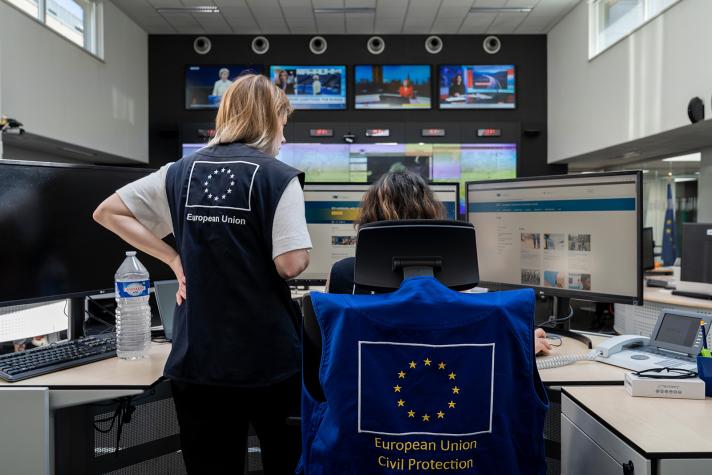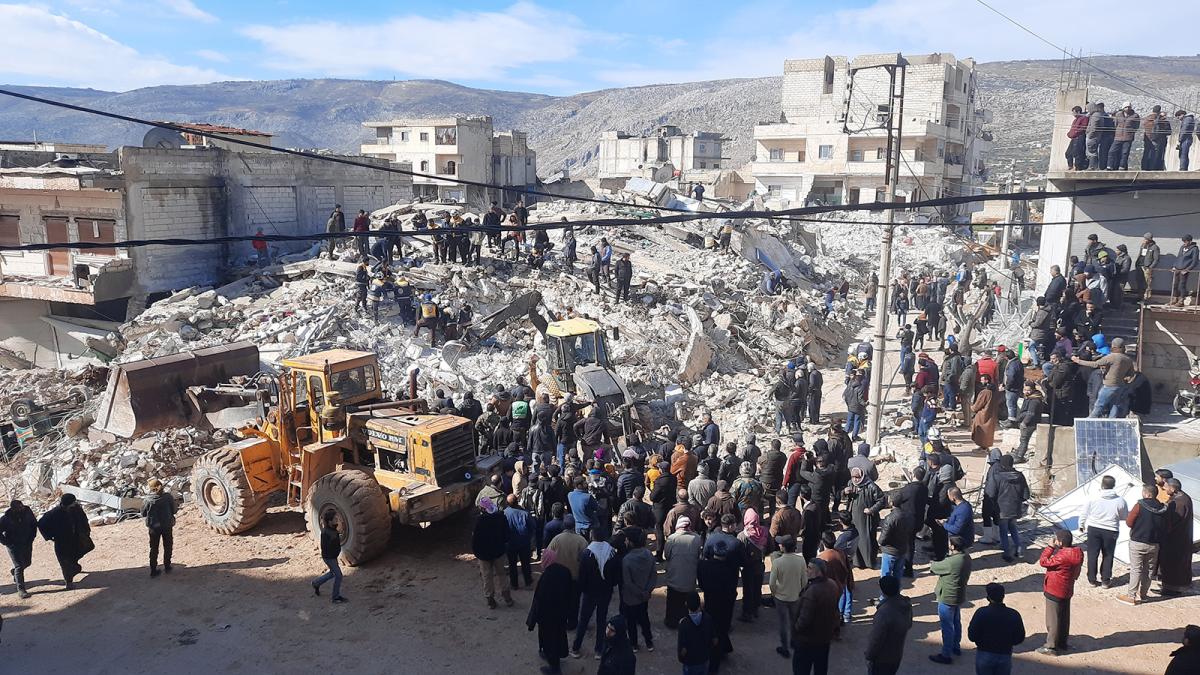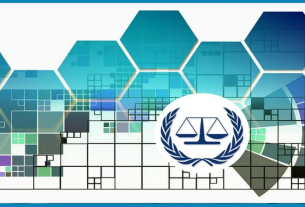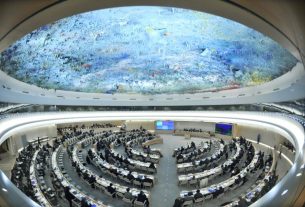Destruction after the earthquake in Northwest Syria
© PIN 2023
On 6 February, a powerful earthquake of magnitude 7.8 – one of the strongest earthquakes in the region in more than 100 years – struck the southeastern Anatolia Region of Türkiye, affecting 10 provinces in Türkiye and 6 governorates in Syria. Another powerful 7.5 quake struck the same day.
This disaster could not have come at a worse time for Syrians. After 11 years of war, the Syria crisis is characterised by unparalleled suffering and humanitarian needs. The EU immediately mobilised all its emergency and humanitarian tools to help Syrian people in need wherever they are. But how is this done?
In Northwest Syria, almost 3 million people were already internally displaced before the earthquake out of a total population of 4 million. Millions of Syrians live displaced in inferior shelter, braving winter conditions, and scarcity.
To support those affected by the earthquake, we followed 6 essential steps.
Step 1: mobilising our humanitarian partners on the ground

EU humanitarian partners assessing the needs after the earthquake and delivering emergency assistance.
© GVC 2023
The EU started helping all Syrians in need since the onset of the conflict in 2011, providing over €27 billion in assistance together with our Member States.
The EU already funds the UN, international NGOs and other international humanitarian organisations inside Syria. Immediately after the earthquake, we got in touch with our partners to see how we could help.
From day one, we closely cooperated with the humanitarian partners on the ground to assess the level of damage and needs inside Syria in the aftermath of the earthquake.
We asked our partners to adjust their ongoing EU grants to respond to the earthquake quickly. An estimated €6 million of existing EU humanitarian grants were redirected by partners for the earthquake response in government and non-government controlled areas.
In addition, we allocated an additional initial amount of €3.7 million of humanitarian assistance to cover the most urgent needs, such as cash for shelter, water and sanitation, health, and search and rescue.
Step 2: activating the EU Civil Protection Mechanism

EU Emergency Response Coordination Centre located in Brussels.
© European Union, 2022 (photographer: Pierre-Yves Jortay)
Following requests for assistance from the Syrian authorities and the World Food Programme, we also activated the EU Civil Protection Mechanism to support the affected people in Syria with in-kind assistance. They asked for search and rescue equipment, shelter, medical equipment and medicines, and other items.
As of 20 February, already 13 European countries (Austria, Bulgaria, Cyprus, Germany, Greece, Finland, France, Italy, Latvia, Poland, Romania, Slovenia and Norway) offered tents, blankets, sleeping bags, mattresses, beds, generators, heaters, medicines, food items, winter clothing, medical equipment and more, to the Syrian people.
Through its Emergency Response Coordination Centre, the EU doesn’t only coordinate all this assistance from our centre located in Brussels and our people on the ground. We also pay up to 100% of the transportation costs of emergency assistance.
Step 3: activating the European Humanitarian Response Capacity

EU humanitarian stockpiles are being loaded onto an airplane in Brindisi, Italy, for a flight to Adana, Türkiye. Afterwards, the EU assistance will be delivered to Syrians in need.
© WFP 2023
In addition to the offers from the European countries, we activated our own European Humanitarian Response Capacity stocks in Dubai and Brindisi.
These EU-owned prepositioned stockpiles of emergency items are positioned in various places in the world so we can quickly deliver them to wherever the emergency is. The stockpiles include winterised tents, heaters, tarpaulins, emergency shelter tool kits, kitchen sets, hygiene kits, and thermal blankets.
To ensure we are effective and work as Team Europe, we included Ireland’s stocks in our deliveries, as they are also stored in Brindisi and Dubai.
The items are now being delivered to the Syrians in need in both government and non-government controlled areas.
Step 4: delivering the assistance to the hubs

On 17 February, emergency assistance from Italy arrived in Beirut, Lebanon. Coordinated via the EU Civil Protection Mechanism, this aid will be delivered to Syria thanks to our humanitarian partners.
© European Union, 2023
For the EU, delivering assistance where it is most needed is a priority. Therefore, we had to quickly find a solution on how to deliver the aid both to the government controlled and non-government controlled areas of the country.
It was of utmost importance to the EU and the Member States that the assistance reaches Syrians in need wherever they are, in an impartial, independent, and unhindered manner.
For this reason, we set up two hubs to deliver the Member States’ and EU assistance to Syrians in need – one in Beirut, Lebanon and one in Gaziantep, Türkiye.
The Member States’ and EU assistance continues arriving at these hubs by air and water. It is met by our staff on the ground, who coordinate the arrivals and ensure everything is in order before the assistance can continue towards Syria.
Step 5: coordinating with our humanitarian partners to reach Syrians

On 15 February 2023, emergency assistance from Romania lands in Gaziantep, Türkiye. Coordinated via the EU Civil Protection Mechanism, this aid will be delivered to Northwest Syria thanks to our partner IOM.
© European Union, 2023 (photographer: Lisa Hastert)
To ensure that the assistance reaches people who need it the most, we are cooperating with our humanitarian partners on the ground, such as the International Organization for Migration (IOM), the World Food Programme (WFP), the International Federation of Red Cross and Red Crescent Societies (IFRC), and the Red Cross and Red Crescent movement.
They operate according to the humanitarian principles of humanity, neutrality, impartiality, and independence. It means they are best placed to identify and deliver assistance to people who need it the most.
Our partner humanitarian organisations have years of experience. They have systems in place to make sure that the assistance is not diverted and reaches those in need.
Therefore, after the assistance arrives to the hubs in Gaziantep and Beirut, we hand it over to the humanitarian partners to deliver it to the Syrian people across the country.
Step 6: assistance is distributed to the people who need it

EU humanitarian partner IOM is delivering Romanian assistance, sent via the EU Civil Protection Mechanism, to people affected by the earthquake in Northwest Syria.
© IOM 2023
Once we hand over all European assistance to the humanitarian organisations, they deliver it to Northwest Syria and the government-controlled areas hit by the earthquake.
Delivering assistance to Northwest Syria, which is non-government controlled, is complicated by the limited number of border crossings between Türkiye and Syria.
A UN Security Council (running until July 2023) authorises only 1 crossing point for the UN agencies: Bab Al-Hawa. However, since 13 February, 2 additional crossing points from Türkiye into Northwest Syria (Bab Al-Salam and Al Ra’ee) were allowed for an initial period of 3 months to respond to the earthquake.
The EU is a strong advocate for this and for opening more border crossings. It is crucial to ensure that we can deliver assistance to those who need it now and beyond the response to the earthquake as humanitarian needs in Syria prevail.
After delivering the assistance to Syria, EU humanitarian partners distribute the delivered items directly to the people. Our partners identify people the most vulnerable people affected by the earthquake and make sure they receive the assistance they need.
To get updates about our assistance to Syrian people, please follow @eu_echo and @ECHO_MiddleEast.
Story by Giedrė Dūdaitė, EU Civil Protection and Humanitarian Aid Operations.
Publication date: 21/02/2023



